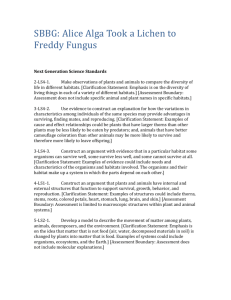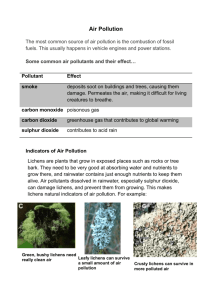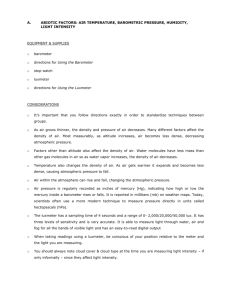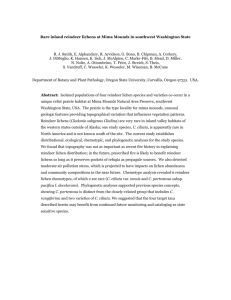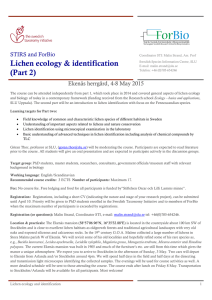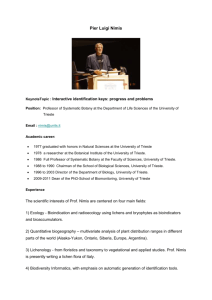Discussion styckesnoteringar
advertisement
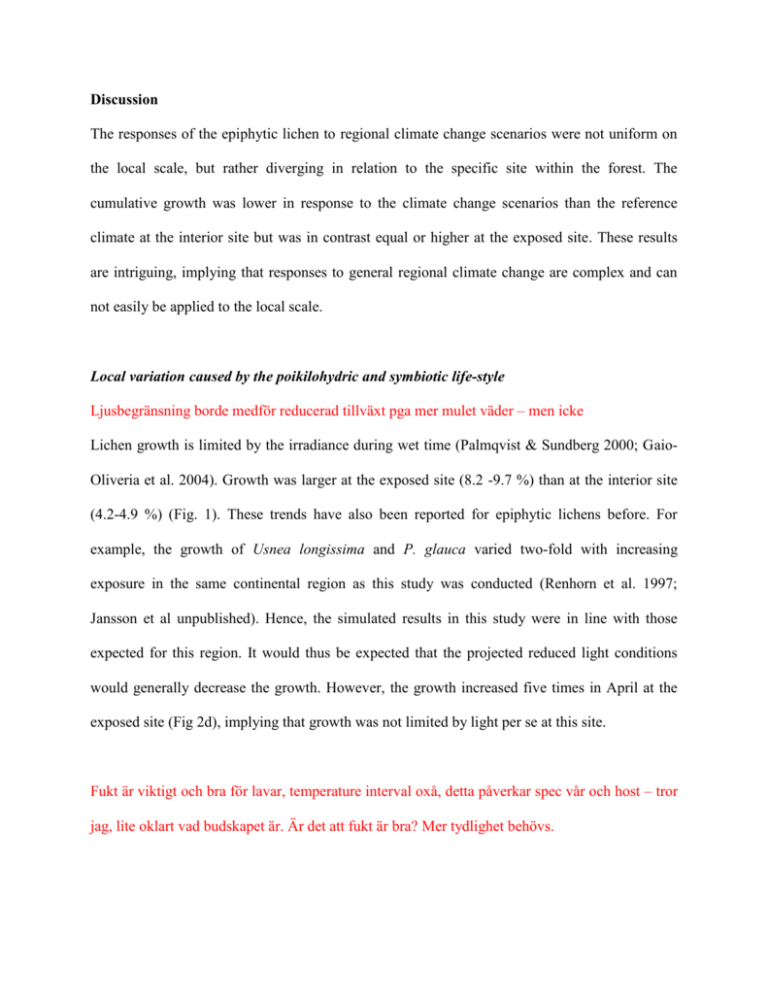
Discussion The responses of the epiphytic lichen to regional climate change scenarios were not uniform on the local scale, but rather diverging in relation to the specific site within the forest. The cumulative growth was lower in response to the climate change scenarios than the reference climate at the interior site but was in contrast equal or higher at the exposed site. These results are intriguing, implying that responses to general regional climate change are complex and can not easily be applied to the local scale. Local variation caused by the poikilohydric and symbiotic life-style Ljusbegränsning borde medför reducerad tillväxt pga mer mulet väder – men icke Lichen growth is limited by the irradiance during wet time (Palmqvist & Sundberg 2000; GaioOliveria et al. 2004). Growth was larger at the exposed site (8.2 -9.7 %) than at the interior site (4.2-4.9 %) (Fig. 1). These trends have also been reported for epiphytic lichens before. For example, the growth of Usnea longissima and P. glauca varied two-fold with increasing exposure in the same continental region as this study was conducted (Renhorn et al. 1997; Jansson et al unpublished). Hence, the simulated results in this study were in line with those expected for this region. It would thus be expected that the projected reduced light conditions would generally decrease the growth. However, the growth increased five times in April at the exposed site (Fig 2d), implying that growth was not limited by light per se at this site. Fukt är viktigt och bra för lavar, temperature interval oxå, detta påverkar spec vår och host – tror jag, lite oklart vad budskapet är. Är det att fukt är bra? Mer tydlighet behövs. Since lichens can not actively regulate their water content, any climate change affecting the wet periods might have larger effect on the responses for poikilohydric organisms than irradiance levels. Generally, lichen growth increased with increased Iwet (Fig 4), which can be obtained by either long wet periods in low light or high irradiance when wet. In this study, the growth response in relation to site exposure was strongly attributed to the irradiance level during wet time, despite the wetter conditions at the interior (Table 3). However, the altered growth responses to projected climate change were mainly attributed to altered hydration patterns. During spring and late autumn, the projected temperature elevation extended the active time for periods near melting point, since this species was projected to be active only for temperatures > 0 °C. The increased assimilation at the exposed site in April during the extended and wetter time periods in sufficient light overbalanced the increased respiration (Table 3, Fig 2, 3d). Similar pattern was also reported for U. longissima, with over two times higher growth responses in relation to identical light exposures in the wetter, sub-oceanic climate compared to the drier, continental climate (Gauslaa et al. 2007). Ökad fukt är inte alltid bra, lokal annan klimat variation viktig samt risk för att det sker när det är tillräckligt varmt men mörkt pga årstid och lokalt mörker. Och då tar bryosarna över symbioserna. 2 budskap alltså, kanske dela upp i två. Lägga bryosar senare. But increased hydration may have contrasting effects locally due to the combined effect with concurrent climate conditions, due to e.g. variations in forest exposure or topography. The increased temperature may also extend the wetter periods in generally dark periods, as exemplified in November. At the interior site, the combination of wetter and warmer conditions in dark resulted in an increased respiration and subsequent decreased growth response compared to reference (Fig 2, 3c). The increased respiration with increased temperature (Sundberg et al. 1999) might besides a negative growth response also decrease the capacity of lichens to manage drought stress (Bewley and Krochko 1982; Farrar 1988)..At the exposed site on the other hand, the lighter conditions offset the respiratory loss (Fig 2). Lichens have a relatively high respiration load per DW due to the large body of fungal tissue compared to algal cells (????). Warmer and wetter conditions in dark may thus affect lichens more severely than for instance bryophytes that have low light compensation point (Proctor 1990). Bryophytes can also cope with higher hydration levels than lichens, due to a water separating structure in some bryophytes (Proctor 1990) whereas lichens can suffer from depressed photosynthesis due to increased CO2 diffusion resistance at high WC levels (Lange et al. 2001). Hence, the symbiotic life-style may be too costly in dark, wet micro-climates and is likely to be outcompeted by bryophytes that are more adapted to these conditions. Varmt och torrt är oxå negativt, (kopplar till förra neg stycket) A warmer and drier climate may also reduce the lichen’s wet time and consequent carbon assimilation, as exemplified in June-August (Fig 2, Table 3). Drier conditions at more light exposed sites may on the other hand favor a poikilohydric life-style (ref). Such conditions are projected for instance in the Mediterranean area (ICPP 2007), but may still occur at more northern altitudes at dry, exposed sites. Generalisera till andra växtformer. Värme, socker men om inte mer ljus uppstår samma problem Although the poikilohydric life-style is characterized by clear temporal water availability, vascular plants with a more even water supply may also be affected differently on a local scale. The growth season will also for vascular plants be prolonged in a warmer climate in northern ecosystems. This extension has mainly been discussed in positive terms by potentially increased timber production (Jarvis & Linder 2000; Zheng et al. 2002). However, if the growth period is extended into the dark period, the effects may be more complex. For coniferous seedlings the cold tolerance was strongly correlated with their soluble sugar contents (Ögren et al. 1997). An extended growth season into dark conditions can therefore increase respiratory loss and deplete the sugar reserves which increase the sensitivity to cold temperatures in subsequent winter period. Also for ground vegetation below insulating snow cover, die-back was caused by respiring soluble sugars in the shoots during mild winters (Ögren 1996). Hence, more light exposed vegetation may still assimilate carbon during the extended growth period whereas the vegetation in the darker areas may suffer from respiratory loss and subsequent cold intolerance. Modeling climate change responses This study show that the local scale responses are not so easily predicted from regional scale climate changes. It was also clearly showed that the local scale responses are the combined effect of regional climate change and the transformation of these micro-climatic variables to local conditions, i.e. forest structure, topography, which is well illustrated by organisms such as lichens. Mikroklimatnivån mycket viktig att använda sig då beräkna biologiska effekter. Annars blir det fel. Men varför biotic också i första meningen? Moreover, when predicting the biological effects of climate change, both abiotic and biotic aspects are important to consider. For example, the projection of merely temperature increase would not render the more complete picture presented here. The combination of various microclimatic factors generates additive effects that are difficult to anticipate. In addition, the contrasting climatic change responses in June were mainly attributed to the diverging projections in humidity variation. Low humidity variation generated a more flat time-series with fewer or shorter peaks with sufficiently high relative humidity to activate the lichen (not shown). This showed that climatic variability can have just as high impact as projected change in averages, and emphasize that predicting future climate change responses demands well-founded assumptions regarding projected climate. Nu kommer biotic…hmm inte bra att ha som inledning I föregående. Biotic – individvariation medför om något så ännu större skillnad inne vs kant The biotic responses in this study represent a lichen adapted to darker environments. However, intra-specific range in performance facilitates some adaptation to the current micro-climate. In more light adapted individuals the amount of algae would increase resulting in a higher GPmax and a decrease in the relative respiration (refs). Hence, at the exposes site the carbon gain would likely be even higher than the simulated responses in this study, and increasingly so for the scenarios. Consequently, the divergence between interior and exposed site would if any be larger if the individual responses would have been adjusted for. Mer biotic – artspecifikt. Speciellt kan det vara andra relationer till temp intervall och fuktintervall /gränser. Lite oklart vad som händer då med kant vs inne. The simulated responses are also affected by the parameterized and/or assumed species specific responses to each variable. For instance, P. glauca was parameterized to be active only for temperatures above freezing. This is realistic for this species (Sundberg et al. 1997); just like for vascular plants. However, lichens can also be activated for subzero temperatures from atmospheric humidity, although the gas exchange at these temperature was low (e.g. Lange et al. 1977; Kappen et al. 1995; Hajek et al. 2001; Lange 2003; Bartak et al. 2007). The results are though still applicable…? In addition, the water response can for other species be more hampered at high water contents (Lange, Green & Heber 2001)). Therefore a projected wetter climate could for those species be further hampered if the water contents reaches high levels. Anpassning till höjd temp, man vet inte mycket, men speculation att resp minskar än mer under torka. Vilket innebär vaddå? Little Not much is known about long-term acclimation of lichens to increased temperatures. This will have effects during the extended active periods in dark with resulting increased respiratory loss of carbon. Acclimation has been reported for vascular plants have (Atkin et al 2005). Sundberg et al (1999) found a decreased respiration rate of lichens lasting up to ten hours and potentially longer after a change in hydration or temperature, hence lasting longer than the initial respiration burst of ca 10-20 minutes (Sundberg et al. 1997). The NCG model was parameterized for NP data acquired after the initial burst, but the respiration may hence decrease further during long hydration periods. Tillväxten kan inte vara resultera I krympning. Lite otydligt slut pga dubbelnegation, men borde vara högre tillväxt inne än predikterat alltså minskar skillnad inne vs kant Moreover, photosynthetic organisms only respires soluble carbohydrates, so during extended hydration periods in dark the thallus can not respire more carbon that was built up in the carbon pool during previous storage periods (Dahlman, Lange?). If this feature would be included in the model the negative growth response would be reduced for the interior location in November. The here developed model related photosynthesis and respiration merely to temperature, but these factors and resultant growth have also shown to be positively correlated to thallus Chl a – content (Palmqvist & Sundberg 2000; Palmqvist et al. 2002; Palmqvist & Dahlman 2006). The Chl a-content varies inter-specifically (Palmqvist et al. 2002), and intra-specifically in response to nitrogen status (Palmqvist et al. 1998; Palmqvist & Dahlman 2006) and light exposure (Jonsson, Moen, Palmqvist, unpublished; Jansson, Esseen, unpublished). The inclusion of Chl a content in the model would however not affect the outcome in this study since the thallusspecific variation in Chl a was very low within the exposure gradient, both before and after the transplantation experiment (Sundberg et al. 1997; Renhorn et al. 1997). However, for the purpose of a multi-species comparison to climate change scenarios this factor would likely be important and therefore included in the model. The empirical responses to climate change will be greatly affected by the reference climate at the local site. The results in this study rely on simulations during one year which of course is a too short time span to interpret long-term climate change. However, realistic seasonal changes were revealed in this study by the joint projections of three important micro-climate variables. These results can thus be extrapolated to years or seasons with different climate conditions. Potential epiphytic community effects The implications of these local scale responses are fascinating. Previous studies on climate change responses have mainly emphasized the northward movement of lichen populations (ref Holland , Håkan?). But these simulation results, however, stresses that lichen populations would rather be redistributed on a local scale towards exposed habitats by the favorable growth conditions at these sites, and thus reinforce the current pattern of increased growth here. Moreover, a northward movement of populations is not obvious in northern ecosystems since organisms may be more hampered by suboptimal light conditions at these latitudes than suboptimal temperatures. The redistribution will favor individuals and species that can survive the potentially adverse effects of growing at these sites. Many species are sensitive to increased wind exposure and the resultant thallus fragmentation, especially those that are sensitive to forest fragmentation e.g. “old forest” lichens Alectoria sarmentosa or Usnea longissima (Esseen & Renhorn 1998; Jansson et al. Unpublished data for U.longissima). These species are suggested to harbor more interior sites, not because the growth conditions are suboptimal at the most exposed sites, but due to their sensitivity to thallus fragmentation. If the growth conditions will be increasingly favored at the exposed sites, lichens must adapt by being less sensitive to wind exposure. The epiphytic flora may at the dark, wetter sites be increasingly constituted by bryophytes, as already discussed. However, lichens can adapt to the prevailing micro-climatic conditions (Hajek et al. 2001). The latter furthermore entails an increased dispersal limitation since new habitats are more distant. The intra-specific response variation facilitates selection for individuals with favorable responses in current micro-climate. These traits are on the other hand unlikely to persist since lichen species also in the future must maintain some plasticity to be able to disperse to new micro-climates and support a viable population. Most likely, the realized niche will be reduced with a transition in optimum abundance towards more semi-exposed habitats. Conclusions Regionally changed climate conditions generated diverging local responses. The local responses are instead affected by how the regional climate change is reflected onto the local scale. Poikilohydric organisms can not regulate their wet active periods. In climate scenarios projecting wetter conditions the responses are diverging on a local scale. Epiphytic lichens will face a higher risk of negative responses in dark, wet ecosystems but a chance to positive responses at wet, exposed sites.


